B.A. (Hons.) English: Theories of Motivation Assignment
VerifiedAdded on 2022/04/06
|18
|2776
|87
Homework Assignment
AI Summary
This assignment, submitted by a student from Indraprastha College for Women, delves into various theories of motivation crucial for effective management. It begins with an overview of motivation and its importance, then examines Maslow's Hierarchy of Needs, detailing each level from physiological needs to self-actualization. The assignment then explores Herzberg's Two-Factor Theory, differentiating between hygiene factors and motivators. It further discusses McClelland's Theory of Needs, highlighting the needs for achievement, power, and affiliation. Contemporary theories, including Goal Setting Theory, Equity Theory, and Expectancy Theory, are also analyzed, providing a comprehensive understanding of how these concepts influence employee behavior and organizational goals. The assignment provides a detailed overview of each theory, discussing their components and practical applications within a professional environment.
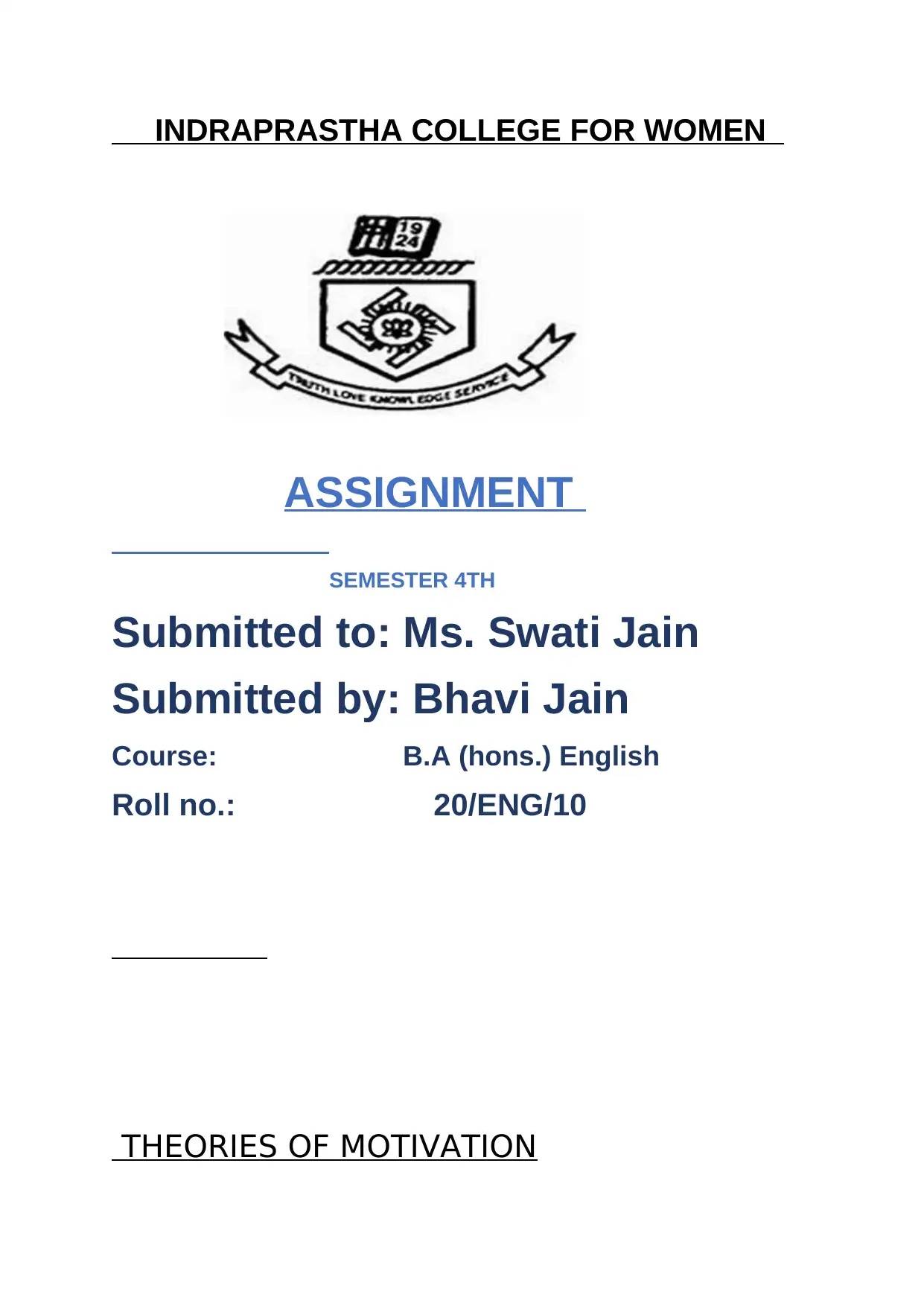
INDRAPRASTHA COLLEGE FOR WOMEN
ASSIGNMENT
SEMESTER 4TH
Submitted to: Ms. Swati Jain
Submitted by: Bhavi Jain
Course: B.A (hons.) English
Roll no.: 20/ENG/10
THEORIES OF MOTIVATION
ASSIGNMENT
SEMESTER 4TH
Submitted to: Ms. Swati Jain
Submitted by: Bhavi Jain
Course: B.A (hons.) English
Roll no.: 20/ENG/10
THEORIES OF MOTIVATION
Paraphrase This Document
Need a fresh take? Get an instant paraphrase of this document with our AI Paraphraser
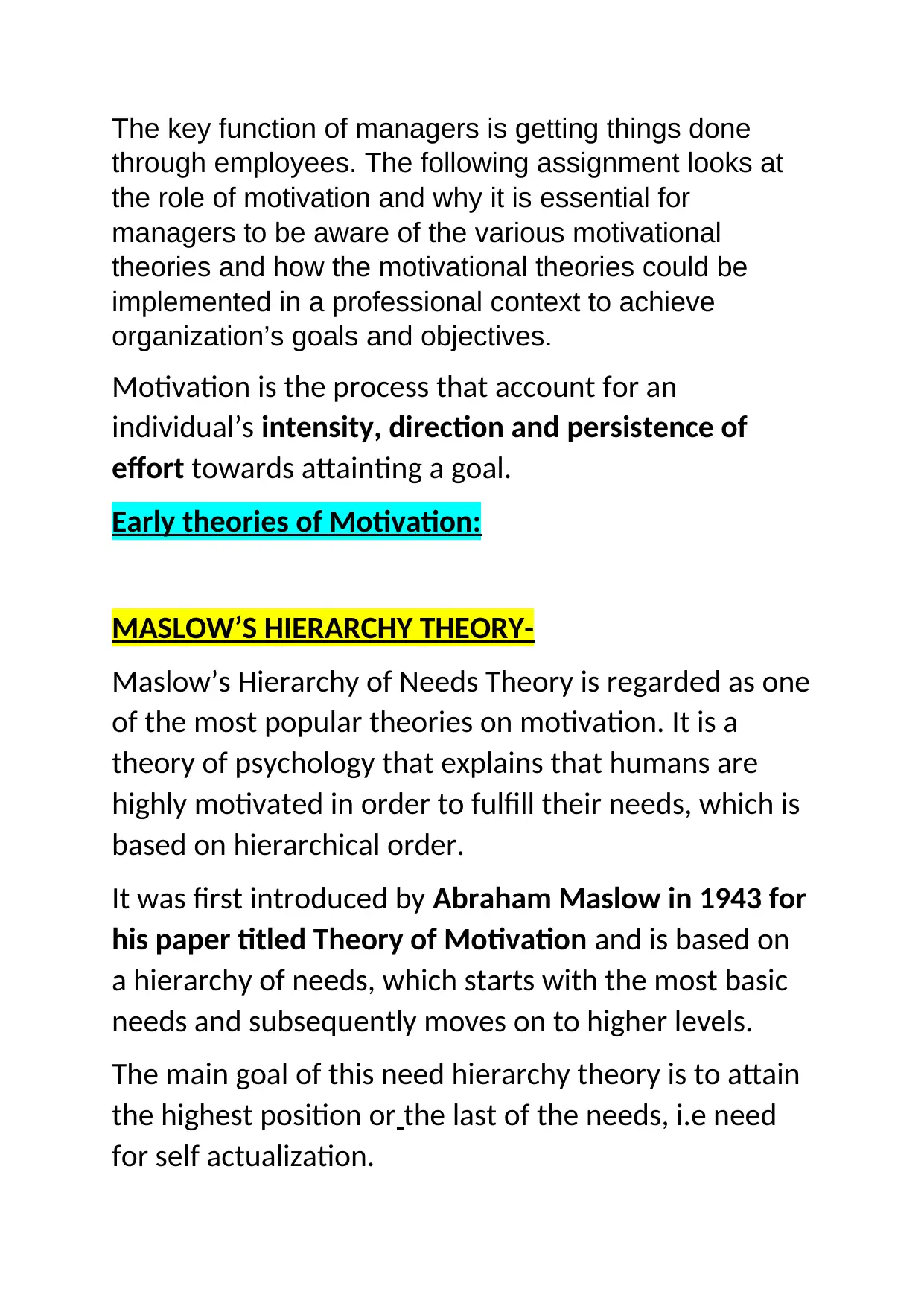
The key function of managers is getting things done
through employees. The following assignment looks at
the role of motivation and why it is essential for
managers to be aware of the various motivational
theories and how the motivational theories could be
implemented in a professional context to achieve
organization’s goals and objectives.
Motivation is the process that account for an
individual’s intensity, direction and persistence of
effort towards attainting a goal.
Early theories of Motivation:
MASLOW’S HIERARCHY THEORY-
Maslow’s Hierarchy of Needs Theory is regarded as one
of the most popular theories on motivation. It is a
theory of psychology that explains that humans are
highly motivated in order to fulfill their needs, which is
based on hierarchical order.
It was first introduced by Abraham Maslow in 1943 for
his paper titled Theory of Motivation and is based on
a hierarchy of needs, which starts with the most basic
needs and subsequently moves on to higher levels.
The main goal of this need hierarchy theory is to attain
the highest position or the last of the needs, i.e need
for self actualization.
through employees. The following assignment looks at
the role of motivation and why it is essential for
managers to be aware of the various motivational
theories and how the motivational theories could be
implemented in a professional context to achieve
organization’s goals and objectives.
Motivation is the process that account for an
individual’s intensity, direction and persistence of
effort towards attainting a goal.
Early theories of Motivation:
MASLOW’S HIERARCHY THEORY-
Maslow’s Hierarchy of Needs Theory is regarded as one
of the most popular theories on motivation. It is a
theory of psychology that explains that humans are
highly motivated in order to fulfill their needs, which is
based on hierarchical order.
It was first introduced by Abraham Maslow in 1943 for
his paper titled Theory of Motivation and is based on
a hierarchy of needs, which starts with the most basic
needs and subsequently moves on to higher levels.
The main goal of this need hierarchy theory is to attain
the highest position or the last of the needs, i.e need
for self actualization.
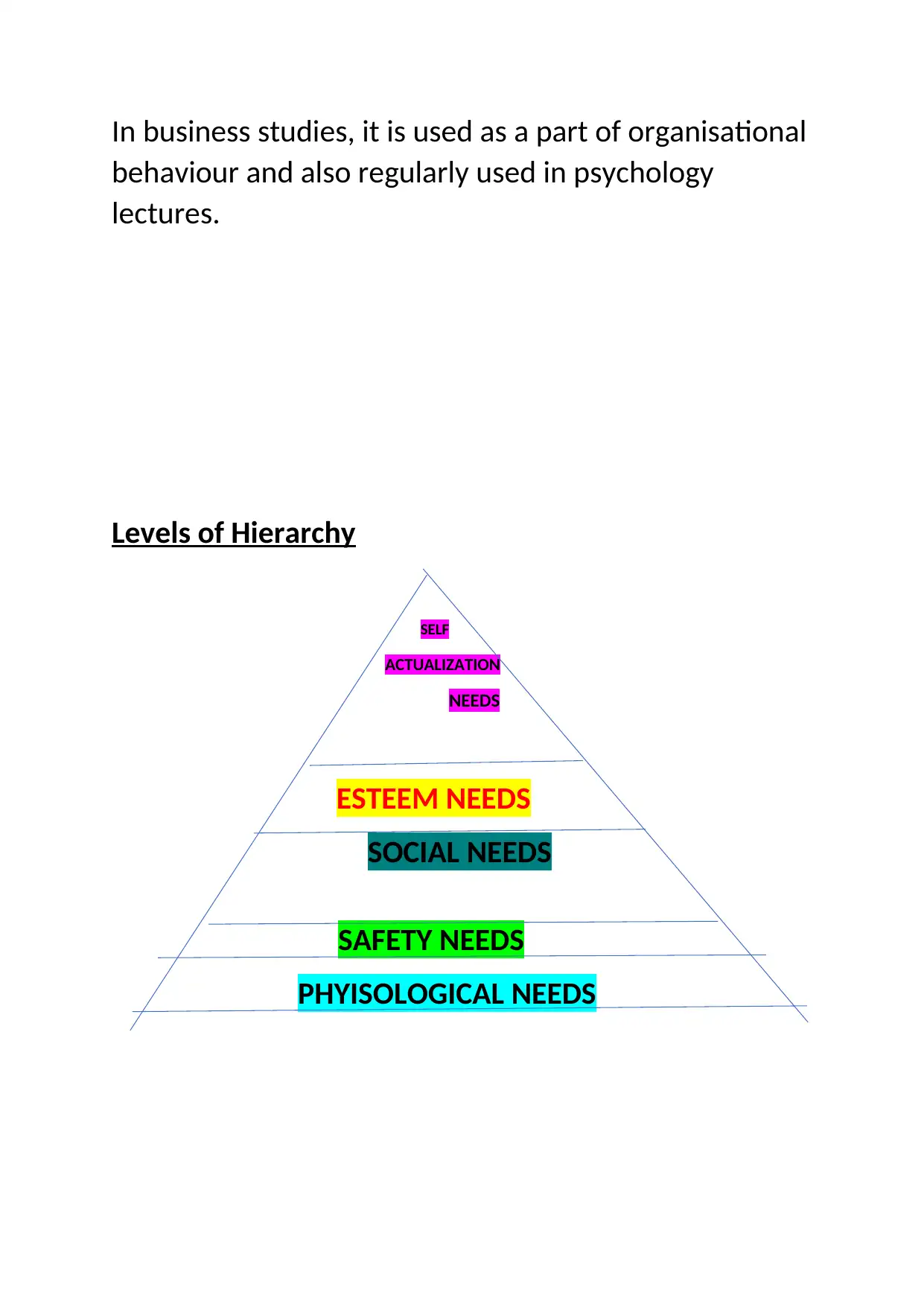
In business studies, it is used as a part of organisational
behaviour and also regularly used in psychology
lectures.
Levels of Hierarchy
SELF
ACTUALIZATION
NEEDS
ESTEEM NEEDS
SOCIAL NEEDS
SAFETY NEEDS
PHYISOLOGICAL NEEDS
behaviour and also regularly used in psychology
lectures.
Levels of Hierarchy
SELF
ACTUALIZATION
NEEDS
ESTEEM NEEDS
SOCIAL NEEDS
SAFETY NEEDS
PHYISOLOGICAL NEEDS
⊘ This is a preview!⊘
Do you want full access?
Subscribe today to unlock all pages.

Trusted by 1+ million students worldwide
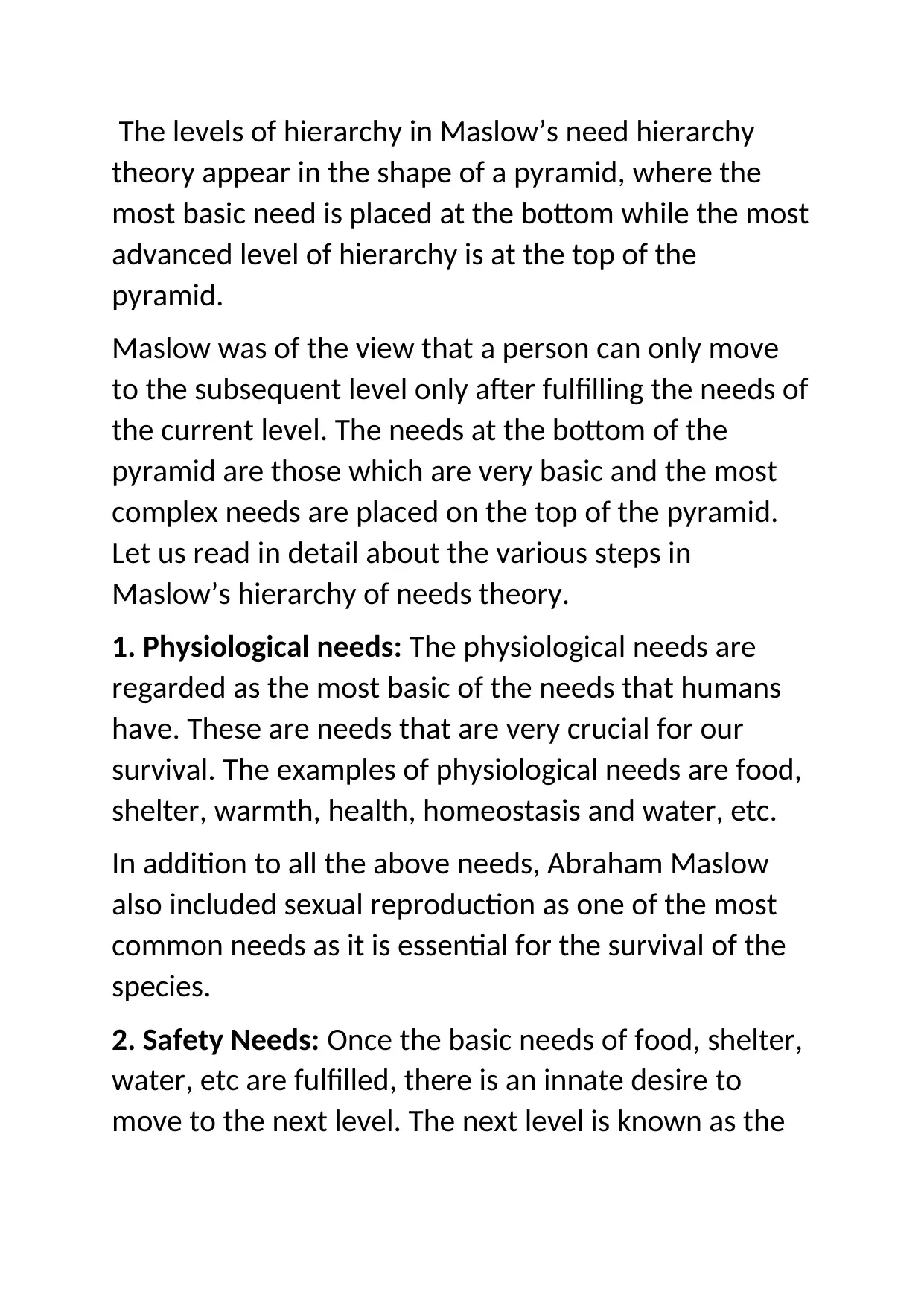
The levels of hierarchy in Maslow’s need hierarchy
theory appear in the shape of a pyramid, where the
most basic need is placed at the bottom while the most
advanced level of hierarchy is at the top of the
pyramid.
Maslow was of the view that a person can only move
to the subsequent level only after fulfilling the needs of
the current level. The needs at the bottom of the
pyramid are those which are very basic and the most
complex needs are placed on the top of the pyramid.
Let us read in detail about the various steps in
Maslow’s hierarchy of needs theory.
1. Physiological needs: The physiological needs are
regarded as the most basic of the needs that humans
have. These are needs that are very crucial for our
survival. The examples of physiological needs are food,
shelter, warmth, health, homeostasis and water, etc.
In addition to all the above needs, Abraham Maslow
also included sexual reproduction as one of the most
common needs as it is essential for the survival of the
species.
2. Safety Needs: Once the basic needs of food, shelter,
water, etc are fulfilled, there is an innate desire to
move to the next level. The next level is known as the
theory appear in the shape of a pyramid, where the
most basic need is placed at the bottom while the most
advanced level of hierarchy is at the top of the
pyramid.
Maslow was of the view that a person can only move
to the subsequent level only after fulfilling the needs of
the current level. The needs at the bottom of the
pyramid are those which are very basic and the most
complex needs are placed on the top of the pyramid.
Let us read in detail about the various steps in
Maslow’s hierarchy of needs theory.
1. Physiological needs: The physiological needs are
regarded as the most basic of the needs that humans
have. These are needs that are very crucial for our
survival. The examples of physiological needs are food,
shelter, warmth, health, homeostasis and water, etc.
In addition to all the above needs, Abraham Maslow
also included sexual reproduction as one of the most
common needs as it is essential for the survival of the
species.
2. Safety Needs: Once the basic needs of food, shelter,
water, etc are fulfilled, there is an innate desire to
move to the next level. The next level is known as the
Paraphrase This Document
Need a fresh take? Get an instant paraphrase of this document with our AI Paraphraser
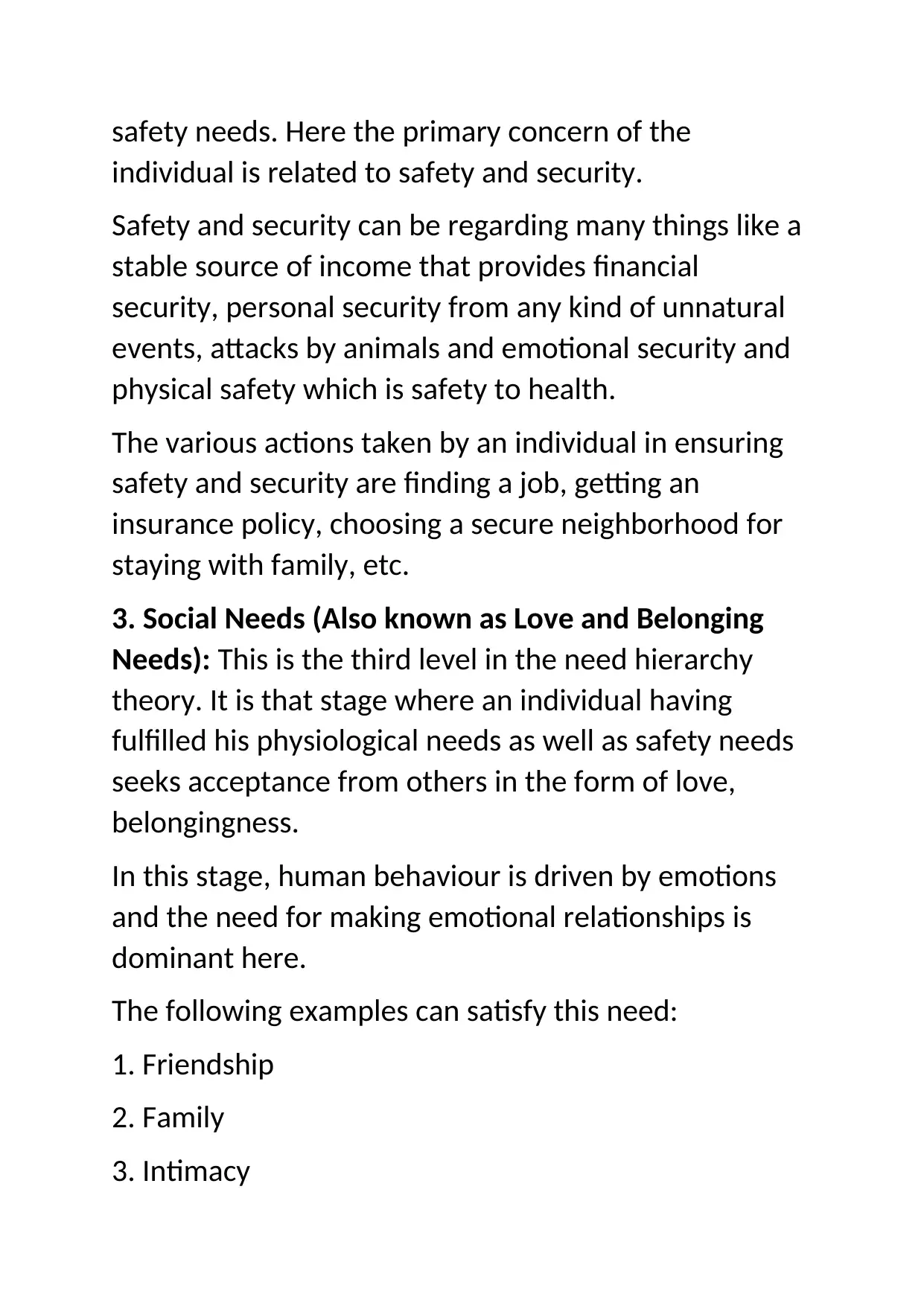
safety needs. Here the primary concern of the
individual is related to safety and security.
Safety and security can be regarding many things like a
stable source of income that provides financial
security, personal security from any kind of unnatural
events, attacks by animals and emotional security and
physical safety which is safety to health.
The various actions taken by an individual in ensuring
safety and security are finding a job, getting an
insurance policy, choosing a secure neighborhood for
staying with family, etc.
3. Social Needs (Also known as Love and Belonging
Needs): This is the third level in the need hierarchy
theory. It is that stage where an individual having
fulfilled his physiological needs as well as safety needs
seeks acceptance from others in the form of love,
belongingness.
In this stage, human behaviour is driven by emotions
and the need for making emotional relationships is
dominant here.
The following examples can satisfy this need:
1. Friendship
2. Family
3. Intimacy
individual is related to safety and security.
Safety and security can be regarding many things like a
stable source of income that provides financial
security, personal security from any kind of unnatural
events, attacks by animals and emotional security and
physical safety which is safety to health.
The various actions taken by an individual in ensuring
safety and security are finding a job, getting an
insurance policy, choosing a secure neighborhood for
staying with family, etc.
3. Social Needs (Also known as Love and Belonging
Needs): This is the third level in the need hierarchy
theory. It is that stage where an individual having
fulfilled his physiological needs as well as safety needs
seeks acceptance from others in the form of love,
belongingness.
In this stage, human behaviour is driven by emotions
and the need for making emotional relationships is
dominant here.
The following examples can satisfy this need:
1. Friendship
2. Family
3. Intimacy
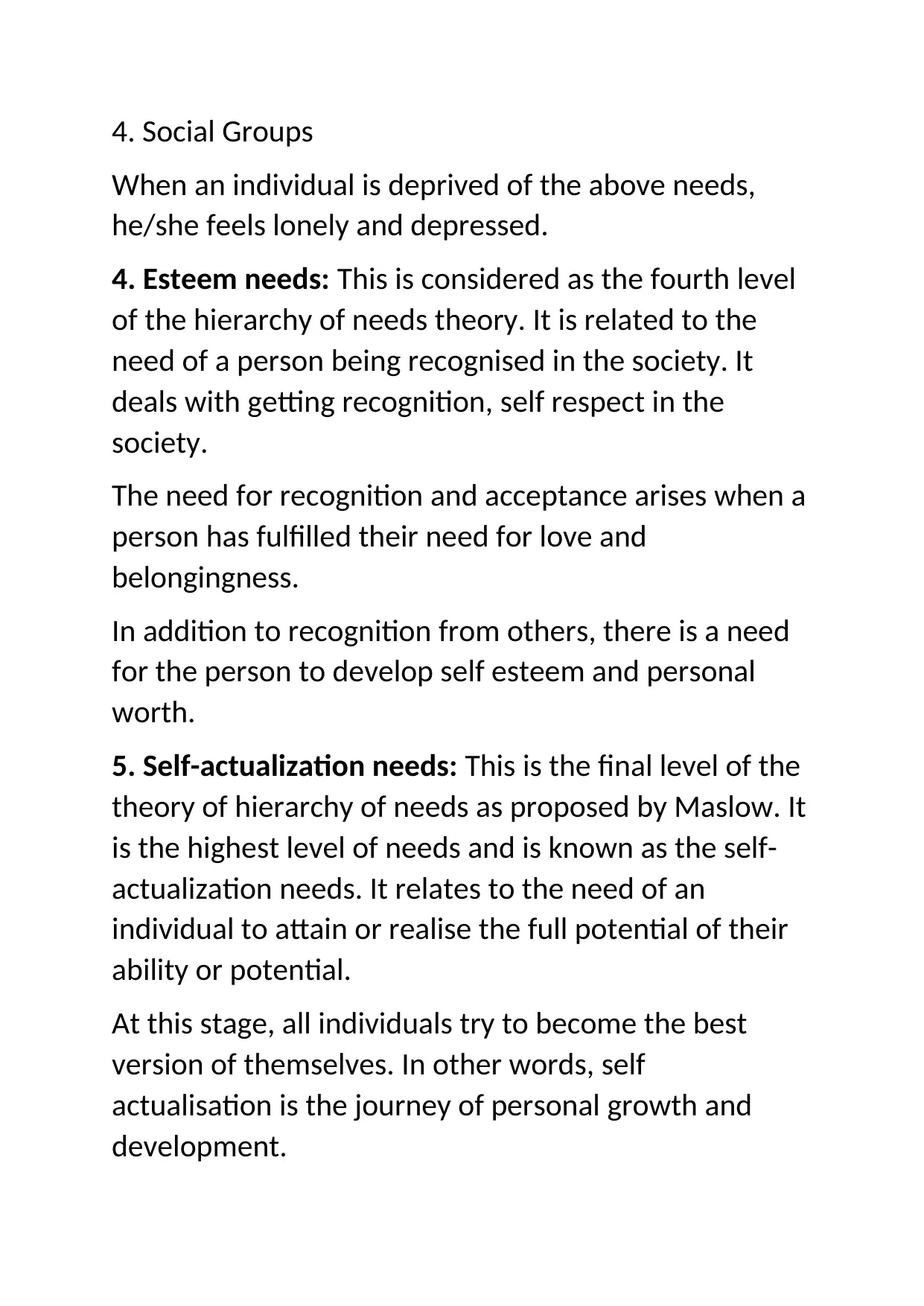
4. Social Groups
When an individual is deprived of the above needs,
he/she feels lonely and depressed.
4. Esteem needs: This is considered as the fourth level
of the hierarchy of needs theory. It is related to the
need of a person being recognised in the society. It
deals with getting recognition, self respect in the
society.
The need for recognition and acceptance arises when a
person has fulfilled their need for love and
belongingness.
In addition to recognition from others, there is a need
for the person to develop self esteem and personal
worth.
5. Self-actualization needs: This is the final level of the
theory of hierarchy of needs as proposed by Maslow. It
is the highest level of needs and is known as the self-
actualization needs. It relates to the need of an
individual to attain or realise the full potential of their
ability or potential.
At this stage, all individuals try to become the best
version of themselves. In other words, self
actualisation is the journey of personal growth and
development.
When an individual is deprived of the above needs,
he/she feels lonely and depressed.
4. Esteem needs: This is considered as the fourth level
of the hierarchy of needs theory. It is related to the
need of a person being recognised in the society. It
deals with getting recognition, self respect in the
society.
The need for recognition and acceptance arises when a
person has fulfilled their need for love and
belongingness.
In addition to recognition from others, there is a need
for the person to develop self esteem and personal
worth.
5. Self-actualization needs: This is the final level of the
theory of hierarchy of needs as proposed by Maslow. It
is the highest level of needs and is known as the self-
actualization needs. It relates to the need of an
individual to attain or realise the full potential of their
ability or potential.
At this stage, all individuals try to become the best
version of themselves. In other words, self
actualisation is the journey of personal growth and
development.
⊘ This is a preview!⊘
Do you want full access?
Subscribe today to unlock all pages.

Trusted by 1+ million students worldwide
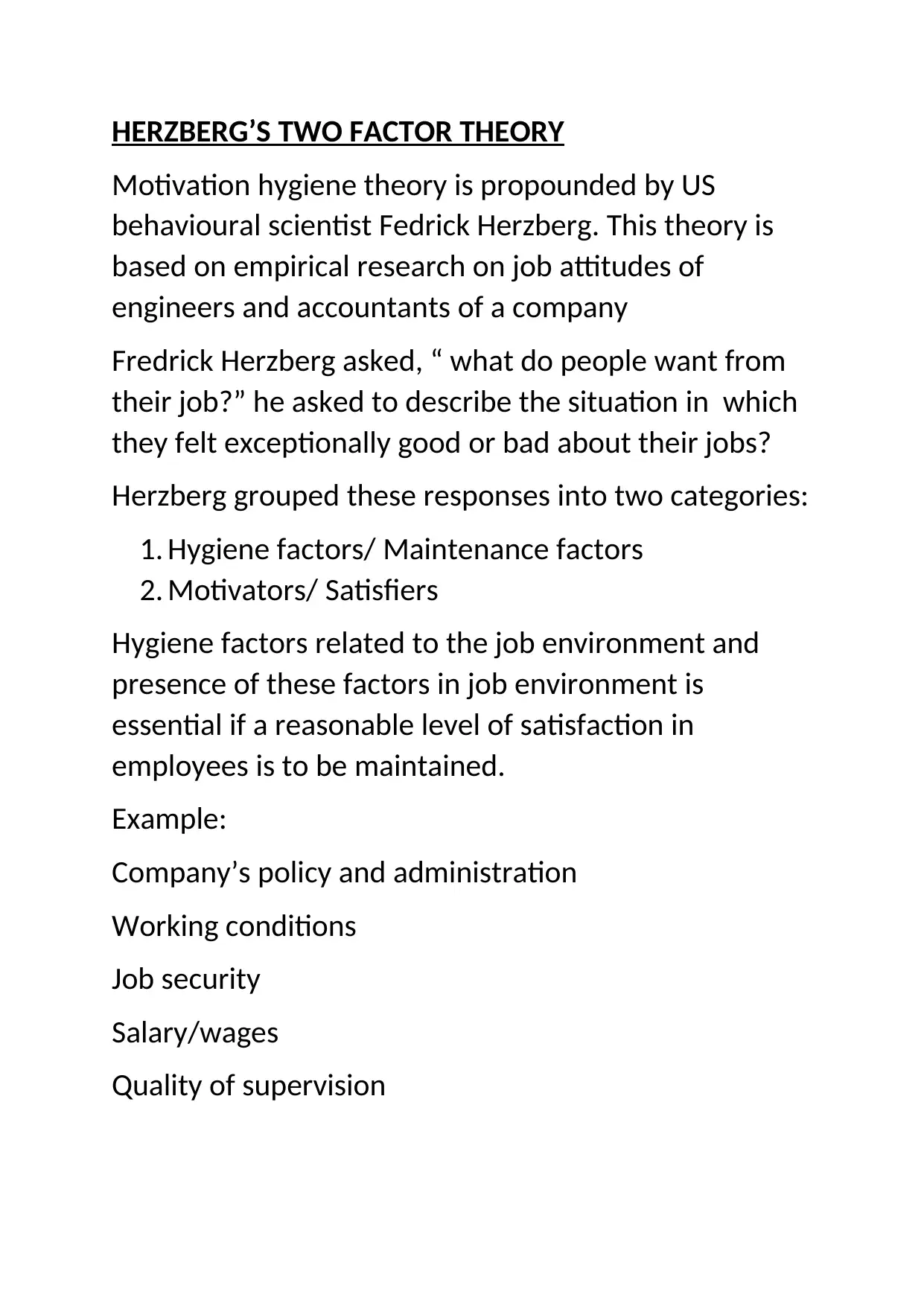
HERZBERG’S TWO FACTOR THEORY
Motivation hygiene theory is propounded by US
behavioural scientist Fedrick Herzberg. This theory is
based on empirical research on job attitudes of
engineers and accountants of a company
Fredrick Herzberg asked, “ what do people want from
their job?” he asked to describe the situation in which
they felt exceptionally good or bad about their jobs?
Herzberg grouped these responses into two categories:
1. Hygiene factors/ Maintenance factors
2. Motivators/ Satisfiers
Hygiene factors related to the job environment and
presence of these factors in job environment is
essential if a reasonable level of satisfaction in
employees is to be maintained.
Example:
Company’s policy and administration
Working conditions
Job security
Salary/wages
Quality of supervision
Motivation hygiene theory is propounded by US
behavioural scientist Fedrick Herzberg. This theory is
based on empirical research on job attitudes of
engineers and accountants of a company
Fredrick Herzberg asked, “ what do people want from
their job?” he asked to describe the situation in which
they felt exceptionally good or bad about their jobs?
Herzberg grouped these responses into two categories:
1. Hygiene factors/ Maintenance factors
2. Motivators/ Satisfiers
Hygiene factors related to the job environment and
presence of these factors in job environment is
essential if a reasonable level of satisfaction in
employees is to be maintained.
Example:
Company’s policy and administration
Working conditions
Job security
Salary/wages
Quality of supervision
Paraphrase This Document
Need a fresh take? Get an instant paraphrase of this document with our AI Paraphraser
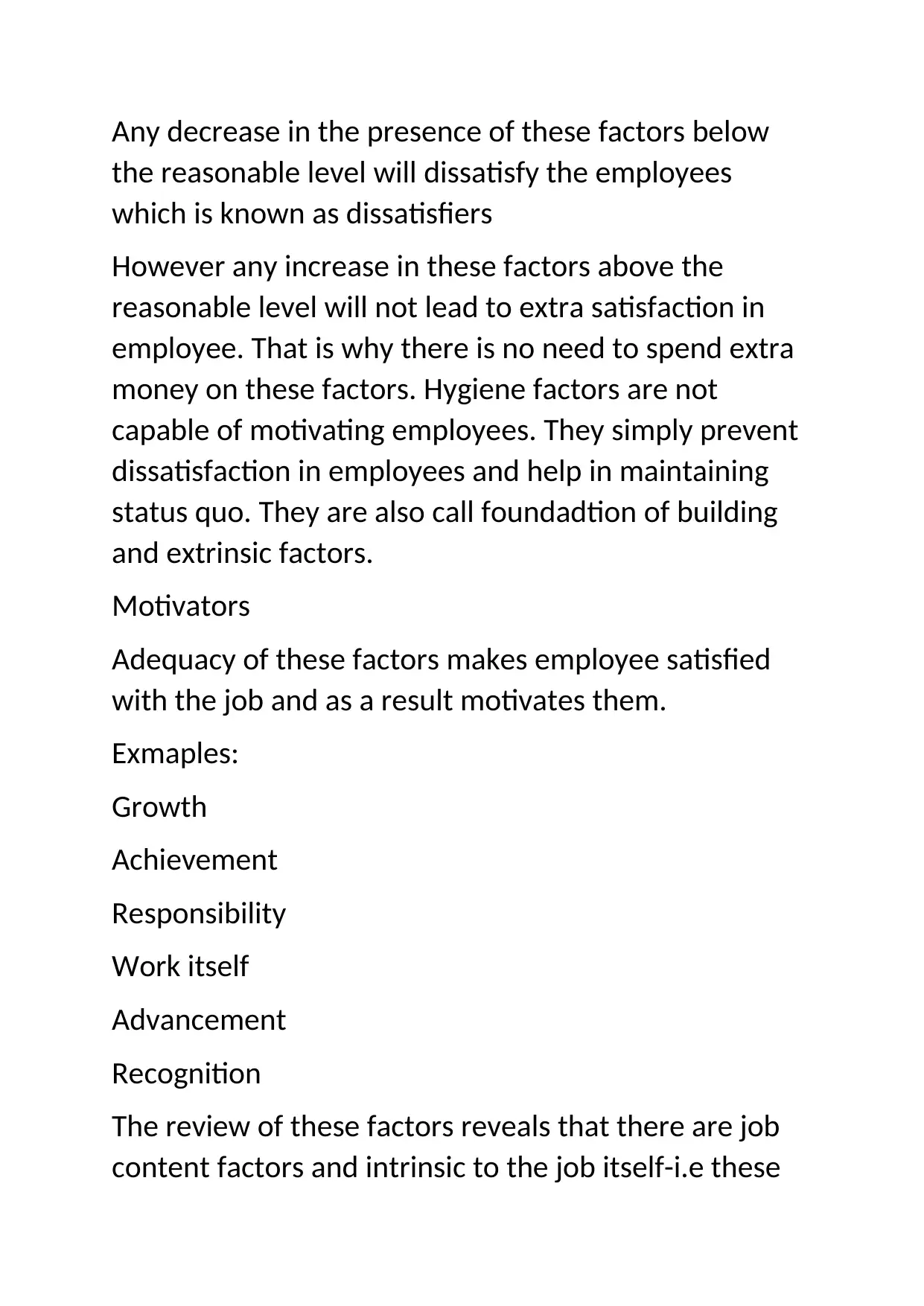
Any decrease in the presence of these factors below
the reasonable level will dissatisfy the employees
which is known as dissatisfiers
However any increase in these factors above the
reasonable level will not lead to extra satisfaction in
employee. That is why there is no need to spend extra
money on these factors. Hygiene factors are not
capable of motivating employees. They simply prevent
dissatisfaction in employees and help in maintaining
status quo. They are also call foundadtion of building
and extrinsic factors.
Motivators
Adequacy of these factors makes employee satisfied
with the job and as a result motivates them.
Exmaples:
Growth
Achievement
Responsibility
Work itself
Advancement
Recognition
The review of these factors reveals that there are job
content factors and intrinsic to the job itself-i.e these
the reasonable level will dissatisfy the employees
which is known as dissatisfiers
However any increase in these factors above the
reasonable level will not lead to extra satisfaction in
employee. That is why there is no need to spend extra
money on these factors. Hygiene factors are not
capable of motivating employees. They simply prevent
dissatisfaction in employees and help in maintaining
status quo. They are also call foundadtion of building
and extrinsic factors.
Motivators
Adequacy of these factors makes employee satisfied
with the job and as a result motivates them.
Exmaples:
Growth
Achievement
Responsibility
Work itself
Advancement
Recognition
The review of these factors reveals that there are job
content factors and intrinsic to the job itself-i.e these
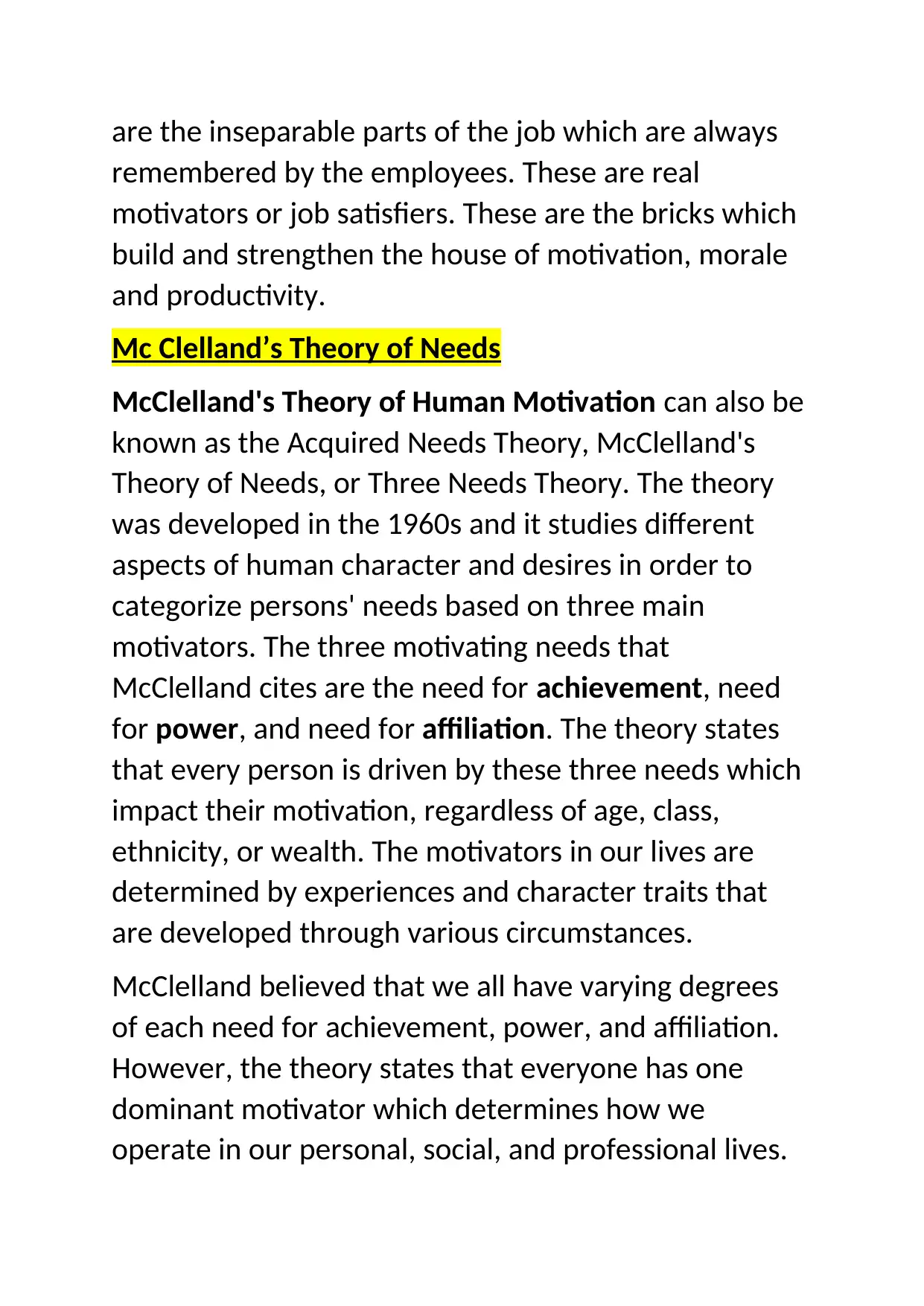
are the inseparable parts of the job which are always
remembered by the employees. These are real
motivators or job satisfiers. These are the bricks which
build and strengthen the house of motivation, morale
and productivity.
Mc Clelland’s Theory of Needs
McClelland's Theory of Human Motivation can also be
known as the Acquired Needs Theory, McClelland's
Theory of Needs, or Three Needs Theory. The theory
was developed in the 1960s and it studies different
aspects of human character and desires in order to
categorize persons' needs based on three main
motivators. The three motivating needs that
McClelland cites are the need for achievement, need
for power, and need for affiliation. The theory states
that every person is driven by these three needs which
impact their motivation, regardless of age, class,
ethnicity, or wealth. The motivators in our lives are
determined by experiences and character traits that
are developed through various circumstances.
McClelland believed that we all have varying degrees
of each need for achievement, power, and affiliation.
However, the theory states that everyone has one
dominant motivator which determines how we
operate in our personal, social, and professional lives.
remembered by the employees. These are real
motivators or job satisfiers. These are the bricks which
build and strengthen the house of motivation, morale
and productivity.
Mc Clelland’s Theory of Needs
McClelland's Theory of Human Motivation can also be
known as the Acquired Needs Theory, McClelland's
Theory of Needs, or Three Needs Theory. The theory
was developed in the 1960s and it studies different
aspects of human character and desires in order to
categorize persons' needs based on three main
motivators. The three motivating needs that
McClelland cites are the need for achievement, need
for power, and need for affiliation. The theory states
that every person is driven by these three needs which
impact their motivation, regardless of age, class,
ethnicity, or wealth. The motivators in our lives are
determined by experiences and character traits that
are developed through various circumstances.
McClelland believed that we all have varying degrees
of each need for achievement, power, and affiliation.
However, the theory states that everyone has one
dominant motivator which determines how we
operate in our personal, social, and professional lives.
⊘ This is a preview!⊘
Do you want full access?
Subscribe today to unlock all pages.

Trusted by 1+ million students worldwide
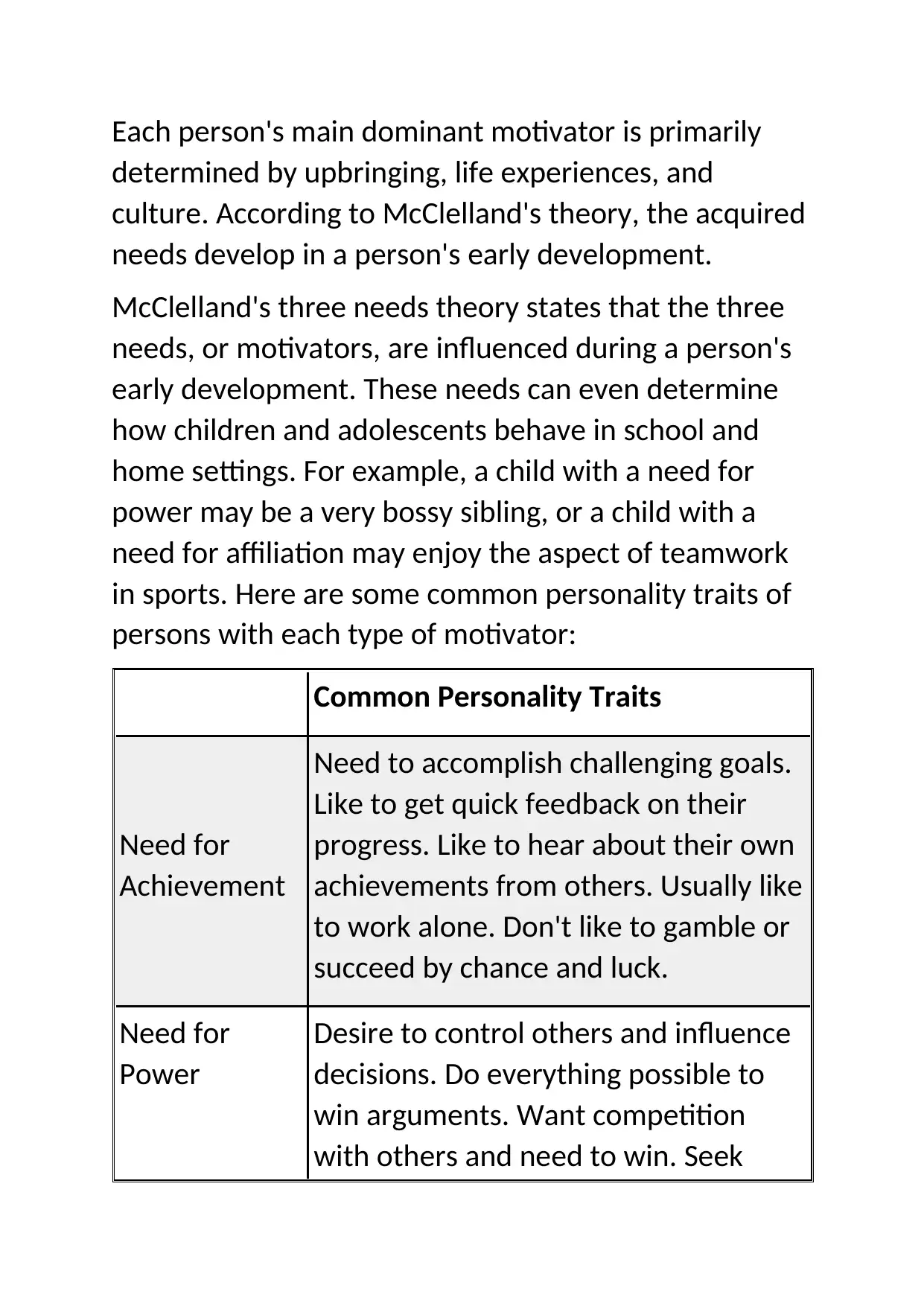
Each person's main dominant motivator is primarily
determined by upbringing, life experiences, and
culture. According to McClelland's theory, the acquired
needs develop in a person's early development.
McClelland's three needs theory states that the three
needs, or motivators, are influenced during a person's
early development. These needs can even determine
how children and adolescents behave in school and
home settings. For example, a child with a need for
power may be a very bossy sibling, or a child with a
need for affiliation may enjoy the aspect of teamwork
in sports. Here are some common personality traits of
persons with each type of motivator:
Common Personality Traits
Need for
Achievement
Need to accomplish challenging goals.
Like to get quick feedback on their
progress. Like to hear about their own
achievements from others. Usually like
to work alone. Don't like to gamble or
succeed by chance and luck.
Need for
Power
Desire to control others and influence
decisions. Do everything possible to
win arguments. Want competition
with others and need to win. Seek
determined by upbringing, life experiences, and
culture. According to McClelland's theory, the acquired
needs develop in a person's early development.
McClelland's three needs theory states that the three
needs, or motivators, are influenced during a person's
early development. These needs can even determine
how children and adolescents behave in school and
home settings. For example, a child with a need for
power may be a very bossy sibling, or a child with a
need for affiliation may enjoy the aspect of teamwork
in sports. Here are some common personality traits of
persons with each type of motivator:
Common Personality Traits
Need for
Achievement
Need to accomplish challenging goals.
Like to get quick feedback on their
progress. Like to hear about their own
achievements from others. Usually like
to work alone. Don't like to gamble or
succeed by chance and luck.
Need for
Power
Desire to control others and influence
decisions. Do everything possible to
win arguments. Want competition
with others and need to win. Seek
Paraphrase This Document
Need a fresh take? Get an instant paraphrase of this document with our AI Paraphraser
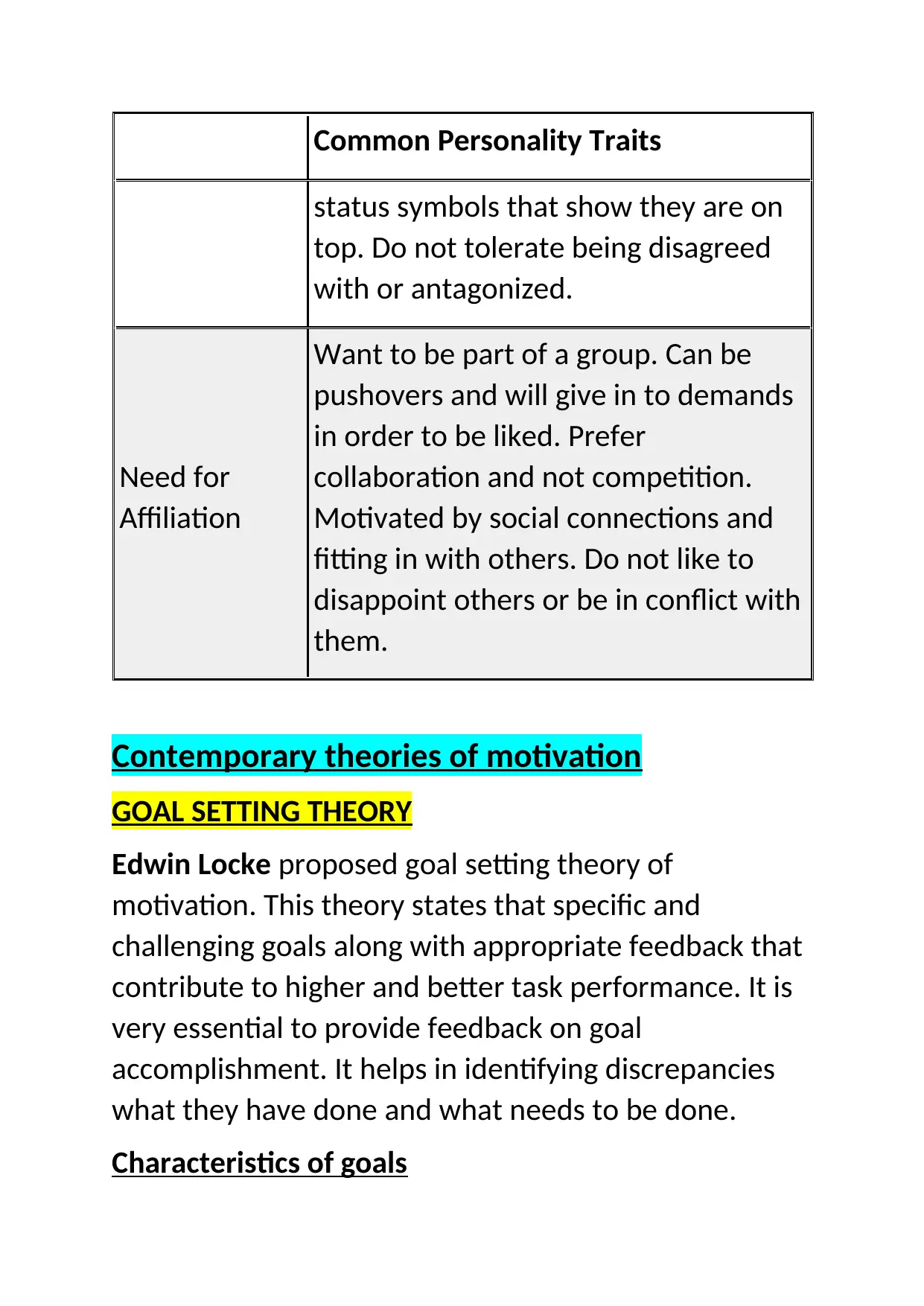
Common Personality Traits
status symbols that show they are on
top. Do not tolerate being disagreed
with or antagonized.
Need for
Affiliation
Want to be part of a group. Can be
pushovers and will give in to demands
in order to be liked. Prefer
collaboration and not competition.
Motivated by social connections and
fitting in with others. Do not like to
disappoint others or be in conflict with
them.
Contemporary theories of motivation
GOAL SETTING THEORY
Edwin Locke proposed goal setting theory of
motivation. This theory states that specific and
challenging goals along with appropriate feedback that
contribute to higher and better task performance. It is
very essential to provide feedback on goal
accomplishment. It helps in identifying discrepancies
what they have done and what needs to be done.
Characteristics of goals
status symbols that show they are on
top. Do not tolerate being disagreed
with or antagonized.
Need for
Affiliation
Want to be part of a group. Can be
pushovers and will give in to demands
in order to be liked. Prefer
collaboration and not competition.
Motivated by social connections and
fitting in with others. Do not like to
disappoint others or be in conflict with
them.
Contemporary theories of motivation
GOAL SETTING THEORY
Edwin Locke proposed goal setting theory of
motivation. This theory states that specific and
challenging goals along with appropriate feedback that
contribute to higher and better task performance. It is
very essential to provide feedback on goal
accomplishment. It helps in identifying discrepancies
what they have done and what needs to be done.
Characteristics of goals
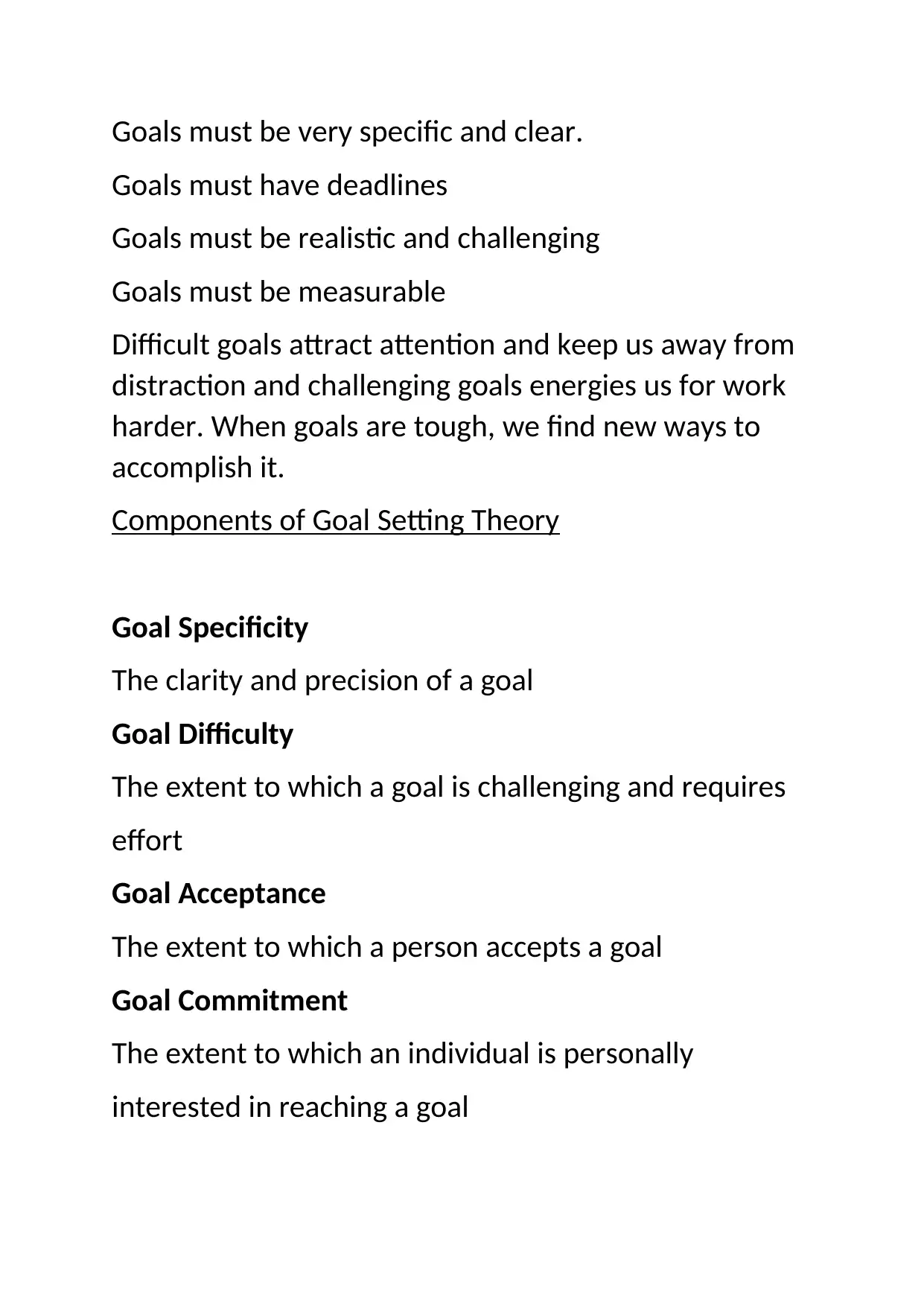
Goals must be very specific and clear.
Goals must have deadlines
Goals must be realistic and challenging
Goals must be measurable
Difficult goals attract attention and keep us away from
distraction and challenging goals energies us for work
harder. When goals are tough, we find new ways to
accomplish it.
Components of Goal Setting Theory
Goal Specificity
The clarity and precision of a goal
Goal Difficulty
The extent to which a goal is challenging and requires
effort
Goal Acceptance
The extent to which a person accepts a goal
Goal Commitment
The extent to which an individual is personally
interested in reaching a goal
Goals must have deadlines
Goals must be realistic and challenging
Goals must be measurable
Difficult goals attract attention and keep us away from
distraction and challenging goals energies us for work
harder. When goals are tough, we find new ways to
accomplish it.
Components of Goal Setting Theory
Goal Specificity
The clarity and precision of a goal
Goal Difficulty
The extent to which a goal is challenging and requires
effort
Goal Acceptance
The extent to which a person accepts a goal
Goal Commitment
The extent to which an individual is personally
interested in reaching a goal
⊘ This is a preview!⊘
Do you want full access?
Subscribe today to unlock all pages.

Trusted by 1+ million students worldwide
1 out of 18
Related Documents
Your All-in-One AI-Powered Toolkit for Academic Success.
+13062052269
info@desklib.com
Available 24*7 on WhatsApp / Email
![[object Object]](/_next/static/media/star-bottom.7253800d.svg)
Unlock your academic potential
Copyright © 2020–2025 A2Z Services. All Rights Reserved. Developed and managed by ZUCOL.




